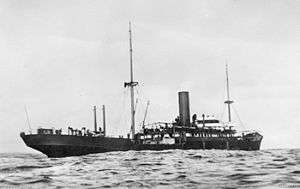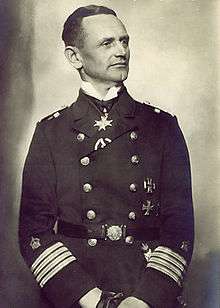SMS Wolf (1913)
 Hilfskreuzer SMS Wolf | |
| History | |
|---|---|
| Name: |
|
| Owner: |
|
| Operator: |
|
| Port of registry: |
|
| Builder: | Flensburger Schiffbau Gesellschaft |
| Launched: | 8 March 1913 |
| Commissioned: | 16 May 1916 |
| Out of service: | 1918 |
| Fate: | Scrapped 1931 |
| General characteristics | |
| Displacement: | 11,200 tons (5,809 GRT) |
| Length: | 135 m (442 ft 11 in) |
| Beam: | 17.10 m (56 ft 1 in) |
| Draught: | 7.90 m (25 ft 11 in) |
| Propulsion: | 1 shaft VTE steam engine, 3 boilers |
| Speed: | 11 knots (20 km/h; 13 mph) |
| Complement: | 348 |
| Armament: |
|
| Aircraft carried: | 1 Friedrichshafen FF.33 seaplane |
SMS Wolf (formerly the Hansa freighter Wachtfels) was an armed merchant raider or auxiliary cruiser of the Imperial German Navy in World War I. She was the fourth ship of the Imperial Navy bearing this name (and is therefore often referred to in Germany as Wolf IV), following two gunboats and another auxiliary cruiser that was decommissioned without seeing action.
Description and history
As a commerce raider, the Wolf was equipped with six 15 cm (5.9 in) guns, three 5.2 cm (2.0 in) guns and several smaller caliber weapons as well as four torpedo tubes. She also carried over 450 mines to be dropped outside enemy ports; she laid one minefield off Australia's southern coast which claimed several ships. Her commander was Fregattenkapitän (Commander) Karl August Nerger who was in charge until her return to Kiel, Germany in February 1918.
The Wolf had not been designed for speed and her top speed was a mere 11 knots (20 km/h). Her advantages included deception (fake funnel and masts which could be erected or lowered to change her appearance), false sides which kept her weapons hidden until the last possible moment, and a range of over 32,000 nmi (59,000 km) thanks to a coal bunker capacity of 8,000 tons (assuming a cruise speed of 8 knots, burning 35 tons of coal daily).[1]
On 30 November 1916 the Wolf left her home port of Kiel with a crew of 348 men. Escorted by the SM U-66 from Skagerrak to the North Atlantic, she passed north of Scotland and turned south going around the Cape of Good Hope, where she laid some of her mines, into the Indian Ocean. She dropped mines at the harbors of Colombo and Bombay, then entered the waters of South Asia, Australia and New Zealand.
With the help of the "Wölfchen" (Little Wolf), a Friedrichshafen FF.33 two-seater seaplane, she located and seized enemy vessels and cargo ships. After transferring their crews and any valuable supplies (notably coal, but also essential metals of which the German war effort had much need) to the Wolf, she then sank the vessels. The Wolf destroyed 35 trading vessels and two war ships, altogether approximately 110,000 tons.
After 451 days she returned to her home port of Kiel on 24 February 1918 with 467 prisoners of war aboard. In addition she carried substantial quantities of rubber, copper, zinc, brass, silk, copra, cocoa, and other essential materials taken from her prizes. The Wolf, without support of any kind, had made the longest voyage of a warship during World War I. Captain Nerger was awarded the highest German decoration, the Pour le Mérite.
For the remainder of the war, the Wolf was employed in the Baltic Sea. After the war she was ceded to France and sold to Compagnie des Messageries Maritimes of Paris, refitted and renamed Antinous. She was scrapped in 1931 in Italy.
A member of the crew was the young Theodor Plivier, who became later a revolutionary, communist, and famous author. In his first novel Des Kaisers Kulis (The emperor's coolies) he assimilates his experience on board the Wolf. The book was transformed in a theatrical play, too, and forbidden after the National Socialist Machtergreifung. Another crew member was Jakob Kinau, brother of author Gorch Fock – Kinau served as a Minenbootsmannsmaat on the Wolf. In his voyage diary, which was published in 1934 in the Quickborn-Verlag, Hamburg, he mentioned some details of a mutiny on board, which was not described in memoirs of other Wolf crew.
The SS Port Kembla was sunk off the coast of the South Island of New Zealand after hitting a mine laid by the Wolf.
Summary of raiding history
In 15 months at sea, Wolf captured and sank 14 ships, totalling 38,391 GRT. She also laid minefields that sank another 13 ships, grossing a further 75,888 GRT. The heaviest loss was the Spanish mail steamer Carlos de Einzaguirre on the way from Cadiz to Manila. It was struck by a mine of the Wolf near Cape Town and sunk in only four minutes. 134 people, including 12 women and five children, died. 24 persons survived.
| Date | Ship | Type | Nationality | Tonnage GRT | Fate |
|---|---|---|---|---|---|
| 27.1.17 | Turritella | Freighter | British | 5.528 | commissioned as Auxiliary Minelayer Iltis; scuttled to avoid capture 15.3.17 |
| 1.3.17 | Jumna | Freighter | British | 4,152 | Sunk |
| 11.3.17 | Wordsworth | Freighter | British | 3,509 | Sunk |
| 30.3.17 | Dee | Sailing ship | British | 1,169 | Sunk |
| 2.6.17 | Wairuna | Freighter | British | 3,947 | Sunk |
| 16.6.17 | Winslow | Sailing ship | US | 567 | Sunk |
| 9.7.17 | Beluga | Sailing ship | US | 507 | Sunk |
| 14.7.17 | Encore | Sailing ship | US | 651 | Sunk |
| 6.8.17 | Matunga | Freighter | British | 1,618 | Sunk |
| 26.9.17 | Hitachi Maru | Freighter | Japanese | 6,557 | Sunk |
| 10.11.17 | Igotz Mendi | Freighter | Spanish | 4,648 | retained as prize; wrecked on Danish coast 24.2.18 |
| 30.11.17 | John H Kirby | Sailing ship | US | 1,296 | Sunk |
| 15.12.17 | Marechal Davout | Sailing ship | French | 2,192 | Sunk |
| 4.1.18 | Storebror | Sailing ship | Norwegian | 2,050 | Sunk |
| Date | Ship | Type | Nationality | Tonnage GRT | Location |
|---|---|---|---|---|---|
| 26.1.17 | Matheran | Freighter | British | 7,654 | Cape Town |
| 12.2.17 | Cilicia | Freighter | British | 3,750 | Cape Town |
| 26.5.17 | Carlos de Eizaguirre | Freighter | Spanish | 4,350 | Cape Town |
| 10.8.17 | City of Athens | Freighter | British | 5,604 | Cape Town |
| 17.2.17 | Worcestershire | Freighter | British | 7,175 | Colombo |
| 21.2.17 | Perseus | Freighter | British | 6,728 | Colombo |
| 16.6.17 | Unkai Maru | Freighter | Japanese | 2,143 | Bombay |
| 24.6.17 | Mongolia | Freighter | British | 9,505 | Bombay |
| 29.7.17 | Okhla | Freighter | British | 5,288 | Bombay |
| 17.11.17 | Croxteth Hall | Freighter | British | 5,872 | Bombay |
| 26.6.18 | Wimmera | Freighter | Australian | 3,622 | Australia |
| 6.7.17 | Cumberland | Freighter | British | 9,471 | Australia |
| 18.9.17 | Port Kembla | Freighter | British | 4,700 | New Zealand |
Film
In February/March 1918 the Bild- und Filmamt (BUFA) produced the 13 minutes silent movie S.M. Hilfskreuzer "Wolf", which was produced in Kiel. It shows, beside from Portuguese Army officers, soldiers or officers from New Zealand or Australia as prisoners of war of the "Wolf".
Gallery
 Aircraft Wölfchen
Aircraft Wölfchen Commander Karl August Nerger
Commander Karl August Nerger Map of the Voyage of Wolf
Map of the Voyage of Wolf Pilots of the Wölfchen
Pilots of the Wölfchen
Bibliography
- Richard Guilliatt & Peter Hohnen, The Wolf: How One German Raider Terrorized the Allies in the Most Epic Voyage of WWI, William Heinemann Publ., Australia, 2009. ISBN 978-1-4165-7317-3
- Paul Schmalenbach, German Raiders: A History of Auxiliary Cruisers of the German Navy, 1895-1945, Naval Institute Press, 1979. ISBN 0-87021-824-7
- Edwin P. Hoyt, Raider Wolf, The Voyage of Captain Nerger, 1916-1918, New York, 1974. ISBN 978-0-8397-7067-1
- Roy Alexander, The Cruise of the Raider Wolf, Yale University Press, 1939.
- Jakob Kinau, Der Adjutant des Todes. Wolfs-Tagebuch, (Quickborn-Verlag), Hamburg 1934.
- Theodor Plivier, Des Kaiser Kulis. Roman der deutschen Kriegsflotte, Berlin 1930.
- Fritz Witschetzky Das schwarze Schiff, Union Deutsche Verlagsgesellschaft, Stuttgart/Berlin/Leipzig, 1920.
- Frederic George Trayes, Five Months on a German Raider: Being the Adventures of an Englishman Captured by the "Wolf" , London : Headley, 1919.
- Karl August Nerger, S.M.S. Wolf, Scherl Verlag Berlin, 1918.
- A. Donaldson, The Amazing Cruise of the German Raider Wolf, New Century Press, Sydney, 1918.
- Fritz Leimbach: 64 000 Seemeilen Kaperfahrt. Erlebnisse eines Matrosen auf dem Hilfskreuzer "Wolf", Berlin (West-Ost-Verlag) 1937, Onlineversion: , Reprint by Maritimepress 2012. ISBN 978-3954271344
- Julio Molina Font: Cádiz y el vapor-correo de Filipinas "Carlos de Eizaguirre", 1904 - 1917. Historia de un naufragio (Cadiz and the Philippine mail steamer "Carlos de Eizaguirre". History of a shipwreck), 2. expanded ed. Cádiz (Universidad de Cádiz, Servicio de Publicaciones) 2007. ISBN 978-84-98281-19-4
References
External links
| Wikimedia Commons has media related to SMS Wolf (ship, 1913). |
- Report on the voyage of the Wolf
- TV-Interview with the author of the book "The Wolf"
- Website of the book The Wolf
- S.M. Hilfskreuzer "Wolf", silent movie, full length, at Bundesarchiv-Filmarchiv
Coordinates: 16°36′S 59°07′E / 16.600°S 59.117°E